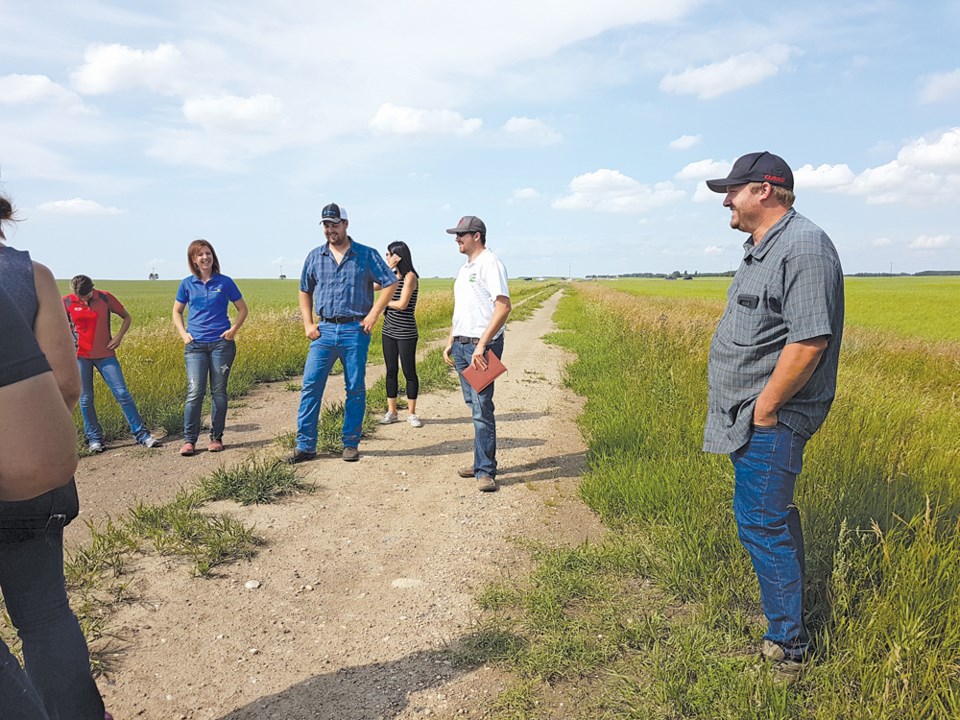There is always something new to learn through agricultural studies. Annaheim producer, Lyle Dosch, is learning that first hand through his partnership with the Ag Demonstrations and Practices and Technologies (ADOPT) program through Canadian Agriculture Partnerships and the Carrot River Valley Watershed.
Dosch, as well as representatives from the watershed, got to show producers and other ag partners his test field during demonstration day on Aug. 2, first with presentations at Annaheim Hall, next at his test field west of Annaheim.
The watershed is testing the efficiency of nitrogen stabilizers in Dosch’s field with the majority of his crop treated with the stabilizer while the rest is not treated. Soil sampling will show the differences in nitrogen levels between treated and untreated strips of the field.
Dosch is eager to see the value the nitrogen stabilizer adds to his field as well as the potential for preventing nitrogen leaching into the environment.
“I hope that the nitrogen stays where it’s supposed to be. It doesn’t disappear, it doesn’t leach away, or disappear into the air. When it is put on, it stays there and if there’s any left, it stays where it’s supposed to be.”
Also included in the demonstration was talks from industry partners on ways producers can effectively use nitrogen on their operations.
Nutrient distribution within the field can vary but they can also be mapped, says Jack Payne with Farmers Edge who offers mapping services. Mapping can give producers an advantage, he says, by offering producers optimal fertilizer use while increasing their returns.
“Getting a handle on that nutrient variability and understanding that variation allows the grower, if they wish to apply variable rate nutrients, to put the nutrients where they are actually needed rather than putting a flat rate on where you may over fertilize some areas of the field and under fertilize others.”
Digital mapping of nutrient variables is becoming more heavily adopted by producers, says Payne who had a successful trip to the 2018 Ag in Motion talking with producers about adopting this practice.
“We have a whole generation of growers now that are wanting this kind of information. Most growers are using their cell phones as a managing tool…you can also use that cell phone to look at soil maps and zone maps in your field. It’s optimizing a farmer’s expenditures on their inputs to match the crop production target units.”
Trish Meyers with the Federated Co-op is working with producers and industry partners in adopting 4R Nutrient Stewardship. She was also in Annaheim to talk about proper nutrient distribution on farm operations.
The four Rs of nutrient distribution ensures producers are using the right source at the right rate at the right time and in the right place to, “increase production/profitability for farms while ensuring the future of the agricultural industry,” said Meyers in her presentation.
Producers have three reasons that adopting this practice is a good idea, she says, since it is socially, economically, and environmentally beneficial to producers.
Consumers are concerned about food production but are often misinformed by social media and television, reported the Canadian Centre for Food Integrity. While they trust farmers for their food information, not everyone has access to producers to get information. Why does that matter, asks Meyers?
Because when they are making decisions on what to buy for their family, many decisions are based on emotion and not science, she says.
“When we start using emotions instead of science based facts, the freedom to operate becomes really difficult on farms. We need to be in the driver seat and start farming up positive stories about farming.”
Nutrient stewardship and four R use of fertilizer does give consumers a positive look into agriculture and many producers already are using four R practices, maybe without even realizing it, says Meyers.
The goal for Fertilizer Canada is to have 20 million acres of four R certified land by 2020.



